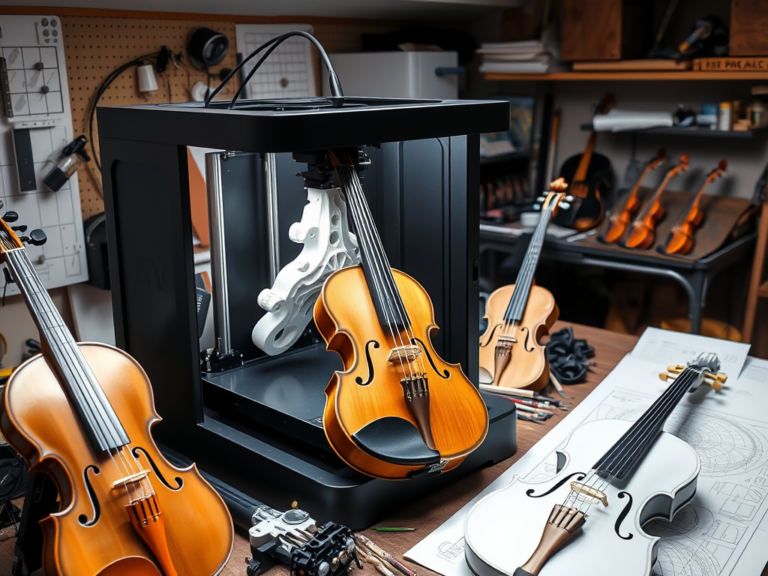
In recent years, this fusion has led to some incredible inventions. One exciting development is the arrival of 3d-printed electric violas. This development not only protects the rich legacy of viola music but also brings current improvements to fit modern artists.

Knowing 3d-printed electric violas
All created utilising 3D printing technology, a 3d-printed electric viola combines the classic viola design with contemporary electric amplification. This technique allows for complex designs and customising previously impossible with conventional techniques by layer-by-layer building the instrument layer from materials like thermoplastics or resins.
Difficulties, Issues, and Thoughts
Though the advantages are clear-cut, there are issues to resolve:
- Achieving the rich, warm tones unique to traditional violas calls for both careful material selection and 3d printing design accuracy.
- Making sure the instrument can withstand frequent usage calls for thorough testing and possibly component reinforcement.
In classical circles, acceptance is
- Concerning 3d-printed instruments, traditionalists could be reluctant. But as technology develops, the quality and promise of these instruments are becoming increasingly appreciated.
Three-dimensional printed electric violas: their future
The junction of 3D printing with electric amplification will alter string instrument production. We should expect as technology develops:
Improved materials: Creation of cutting-edge printing techniques reflecting wood’s acoustic characteristics.
Enhanced Accessibility: More musicians find reasonably priced, premium instruments catered to their demand.
Music teachers, including these ideas in their courses, expose their pupils to the mix of technology and heritage.
Benefits of 3D printing for instrument manufacturing
Customising:
- Musicians can customise their instruments to match particular ergonomic requirements or aesthetic tastes. Perfect size, form, and design element changes are made possible by 3d printing.
- Traditional, handcrafted violas can be costly, due to labour-intensive techniques and material costs. 3D printing lowers manufacturing costs, so enabling a broader audience to obtain excellent equipment.
Modern Designs:
- 3D printing’s adaptability lets one explore unusual forms and structures, hence improving playability and sound quality.

Electrical amplification: Growing Musical Horizons
Including electric parts in the viola gives musicians fresh directions.
From classical acoustics to contemporary electronic effects, electric violas may generate a broad spectrum of tones fit for many different music genres.
Performance Variables: Whether in small venues or large concert halls, amplification enables musicians to perform in various locations and ensures that their sound reaches listeners effectively.
READ MORE – Ultimate Guide to Creating a 3d-Printed Robot with a Camera: Step-by-Step Instructions
FAQs
1. In what ways is a 3d-printed electric viola different from a conventional viola?
Using additive manufacturing techniques, a 3d-printed electric viola is built, allowing for the integration of electric components for amplification and customisation. Traditional violas, on the other hand, are made by hand from wood and depend solely on acoustic sound generation.
2. Could a 3d-printed electric viola reproduce the sound of a wooden viola?
Although 3d printing materials and design have produced excellent sound quality, it is difficult to replicate the precise tonal qualities of a wooden viola. Still, many artists value the unusual sound and adaptability of 3d-printed electric violas.
3. Are 3d-printed electric violas fit for public performances?
Indeed, several professional musicians, especially in genres that profit from amplification and sound effects, use 3d-printed electric violas. The build quality of the instrument and the musician’s particular needs determine compatibility.
4. A 3d-printed electric viola requires what maintenance?
Regular cleaning, string replacement, and ensuring the electrical components operate as they should define maintenance for conventional electric violas. Following the manufacturer’s care instructions is vital.
5. Where might I get a 3d-printed electric viola?
3d-printed electric violas are available from several specialist luthiers and producers. Researching and consulting reliable sources will help you identify an instrument that satisfies your tastes and quality criteria.
Conclusion:
3d-printed electric violas reflect a harmonic fusion of innovation and history. Using contemporary technology gives musicians the chance to honour the rich tradition of the viola while exploring fresh creative possibilities. This field’s development promises to enhance the musical scene with instruments that are both artistically motivating and readily available.